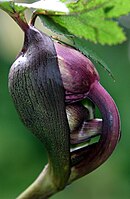
Photo from wikipedia
Chloroplasts are the organelles that perform energy transformation in plants. The normal physiological functions of chloroplasts are essential for plant growth and development. Chilling is a common environmental stress in… Click to show full abstract
Chloroplasts are the organelles that perform energy transformation in plants. The normal physiological functions of chloroplasts are essential for plant growth and development. Chilling is a common environmental stress in nature that can directly affect the physiological functions of chloroplasts. First, chilling can change the lipid membrane state and enzyme activities in chloroplasts. Then, the efficiency of photosynthesis declines, and excess reactive oxygen species (ROS) are produced. On one hand, excess ROS can damage the chloroplast lipid membrane; on the other hand, ROS also represent a stress signal that can alter gene expression in both the chloroplast and nucleus to help regenerate damaged proteins, regulate lipid homeostasis, and promote plant adaptation to low temperatures. Furthermore, plants assume abnormal morphology, including chlorosis and growth retardation, with some even exhibiting severe necrosis under chilling stress. Here, we review the response of chloroplasts to low temperatures and focus on photosynthesis, redox regulation, lipid homeostasis, and chloroplast development to elucidate the processes involved in plant responses and adaptation to chilling stress.
Journal Title: Frontiers in Plant Science
Year Published: 2018
Link to full text (if available)
Share on Social Media: Sign Up to like & get
recommendations!